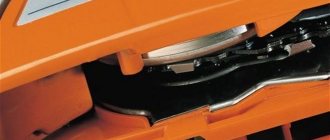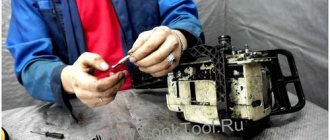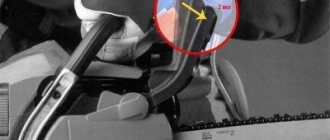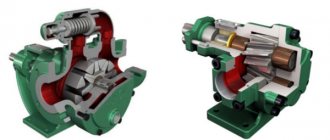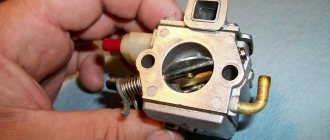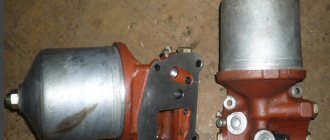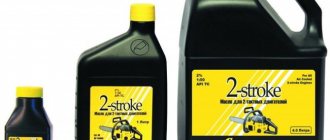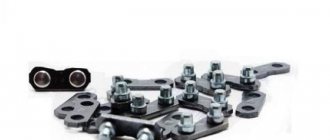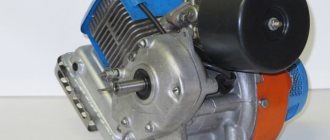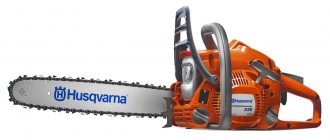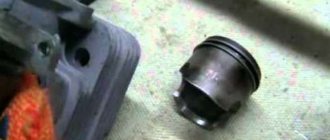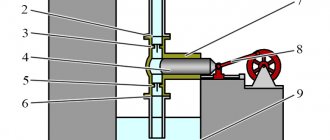Oil pump malfunctions
Regardless of the manufacturer, any chainsaw model experiences problems with the lubrication system.
Chainsaw oil pump assembly
The nature of malfunctions in the lubrication system can be different, and therefore, before starting repairs, it is necessary to accurately determine the cause of the oil leak or its failure to reach the tire. If we exclude the possibility of mechanical damage, the following breakdowns of the lubrication system can be identified:
- The connection between the line and the output channel of the chainsaw oil pump is not airtight;
- Not a tight fit of parts in the plunger system;
- Inconsistency between the parameters of the discharge chamber and the dimensions of the plunger;
- Lack of tightness of the oil line with the inlet fitting of the oil pump.
It is quite easy to eliminate oil leaks from a chainsaw if it is not used for a long time. To do this, you will need several screwdrivers and locksmith keys.
Reasons for decreased system performance and efficiency
The required amount of oil is not supplied to the chainsaw chain for several reasons. The most common failures include:
- clogging of the filter located in the oil tank;
- mechanical failure of one of the pump worm drive elements;
- In winter, the performance of the blower is reduced due to filling the system with too thick oil.
In the latter case, the drive and all pump parts operate under increased loads, causing serious mechanical damage.
Preventative maintenance of chainsaws
Sharpening the saw is done independently using tools and a file or on a sharpening machine. It is produced when cutting edges are worn out or minor chips on the teeth.
Filters are changed periodically in accordance with the manufacturer's recommendations. Air, oil and fuel cells are subject to renewal.
Spark plugs are replaced after a certain time, guided by operating requirements.
Refueling. Different manufacturers and engine types determine the composition of the fuel mixture - a 2-stroke or 4-stroke gasoline engine is filled with gasoline with or without the addition of oil.
More complex work - repair of the piston group, gearbox, clutch, etc. - is carried out as events occur. Such work is usually carried out in specialized repair shops.
A properly configured chainsaw is the key to safe and highly productive work. Remember this!
Video on how to properly tension a chainsaw chain.
Video about adjusting the oil supply for chain lubrication.
Home page » Adjusting Oil on a Chainsaw
Types of plunger pumps
Plunger pumps installed on modern chainsaws are:
- Adjustable;
- Unregulated.
Unregulated pumps are usually installed on household-grade tools, for example Yamamoto CS-4552, Husqvarna 135 Mark II, Kruger GCSK 35-45, Husqvarna 120 Mark II. Such units provide a stable supply of working fluid regardless of operating conditions. They have a simple but reliable design. Their disadvantages include the lack of adjustment of the supply of lubricant to the friction surfaces.
Adjustable pumps are installed on chainsaws of semi-professional and professional classes, such as powerful chainsaws from Energomash, American McCulloch, Procraft, Parma. They have a more complex design.
The adjustment function is necessary when the saw is operating under difficult operating conditions, when the amount of working fluid specified by the manufacturer is not enough to properly lubricate the saw set. In addition, it may be needed when the plunger is slightly worn, when the pump cannot provide enough oil to lubricate the bar and chain.
The photo shows 3 types of adjustable oil pumps
Repairing an oil pump on a chainsaw
Any owner is pleased with good technology, tested in practice and proven itself more than once. New technology always amazes and alarms with its features that surpass the properties of very old technology, which is still in use by many.
Some craftsmen always try to purchase equipment from well-known companies of a certain brand for their own business and persuade their friends and acquaintances to do so, others focus on cost and acquire only precious things for themselves, and the company does not interest them.
Where is the guarantee that no matter what equipment we purchase one hundred percent corresponds to the property certificate under which it is sold? Where is the durability promised by the manufacturer if we operate their equipment according to our criteria, and moreover, “feed” it with our fuel and according to our recipes?
Nowadays, there is a lot of equipment that can be sold at different prices at different retail outlets. No one will say where and who collected the lawn mower or chainsaw that you received. A recognizable brand, and assembly can be carried out in an adjacent garage using components, perhaps even using a makeshift method.
Many chainsaw owners have noticed an oil stain on the place where their chainsaw
. The oil under the saw does not immediately begin to leak. And if the assembly is poor, or rather, if the chainsaw is poorly assembled, an oil stain may appear immediately after refueling.
Except for mechanical damage to the oil tank and oil supply system, there are few circumstances for oil leakage.
- The connection between the oil supply line and the inlet channel of the chainsaw oil pump is not tight and the tightness between the opening of the oil tank and the line is weak.
- Technical compliance of the dimensions of the plunger and the discharge chamber of the oil pump.
- Not a tight connection of the supply line with the output channel of the oil pump to the place where the saw chain is lubricated.
- Violation of the density of the plunger chamber of the oil pump.
I will dwell on the last option in more detail, because specifically in the case of loss of density of the plunger chamber, oil leaks, and in saw designs where the oil tank is located at a level higher than the oil pump, oil leaks out within a couple of days of the chainsaw being idle.
Remove oil leakage from the chainsaw oil pump
it is possible and all this happens quickly if someone has a good screwdriver and wrenches. If your chainsaw has had a short working life, then the problem can be easily solved.
As I mentioned earlier, the guarantee of trouble-free operation of your chainsaw is ensured not only by observing good operating conditions for it and implementing the manufacturer’s recommendations, it is also ensured by the appropriate quality of the components, and most of all, by the highest quality assembly.
A similar plunger-type oil pump, installed on most models of economical chainsaws, is simple in design. The principle of its operation does not differ from the operation of some plunger oil pumps of other categories of chainsaws.
I will briefly outline in my own words the mechanism of operation of a plunger-type oil pump of similar models, so that it would be a little clearer when familiarizing yourself with my method of correcting oil leaks through the oil pump of a chainsaw.
Diagnostics
Diagnostics should begin with inspecting and checking the oil receiver (filter) of the Stihl 180 saw. Typically, if the filter is very dirty, the oil supply may run out.
Next, you need to remove the drum sprocket and check the condition of the drive gear.
The thread on it must be correctly expressed, not licked and not have any other flaws; also, with the gear removed, you need to check the wire lever.
It must press the gear tightly and not turn; otherwise, the gear stands still and does not transmit force to the pump, as a result of which the oil supply stops.
If all the methods listed above to find and remove faults do not produce results, you need to use the last measures, i.e. dismantle the pump.
Oil pump - where is it located?
To repair the oil pump, you will need a set of screwdrivers, rags and wrenches.
First you need to remove the chain and unscrew the bolts that secure the guide chain to the saw body. Removing and replacing the blade on a circular saw; How to remove the disk and change the old circle to.
After which the pump itself is removed. Its placement is indicated by an arrow in the image below.
How to clean?
After removing the pump, it is necessary to carry out a visual inspection of the housing and individual elements. Particular attention should be paid to the condition of the internal part of the housing in which the plunger rotates.
As a result of using low-quality oil, layers of dirt may form inside. In addition, excessive wear on the plunger may occur, resulting in unstable pump operation or oil flow failures.
In order to disassemble the adjustable oil pump, you must perform the following algorithm:
- Using a flat-head screwdriver, remove the plastic plug located at the end of the pump;
- Move the drive gear to the side;
- Without releasing the gear, remove the adjusting shaft by pulling it to the side;
- Remove the plunger from the mounting hole;
After removing and disassembling the oil pump, it is necessary to inspect its internal surfaces for deformations and signs of excessive wear. If necessary, replace failed elements.
The inlet and outlet channels must be cleaned using a feeler gauge made of thin metal wire. Remaining dirt can be removed with a jet of compressed air. The oil pump elements are assembled in the reverse order.
We recommend watching the video, the author of which clearly shows how to disassemble the oil pump.
Knowing the structure and operating principle of the plunger oil pump installed on a chainsaw, you can clean and replace it yourself. This does not require the use of special skills or the use of a special tool. All work, if you have enough free time and desire, can be done on your own.
Chainsaw fuel system design
The fuel system of a chainsaw is not only a gas tank into which a freshly prepared mixture consisting of gasoline and special oil is poured. The fuel system includes the following elements:
- Gas tank, the volume of which is up to half a liter
- Fuel filter located directly inside the gas tank
- The fuel line or hose through which the gasoline-oil mixture enters the carburetor
- Fuel tank cap with breather. Few people know what a breather is, but it is an important part in the design of a gas-powered tool, which is responsible for balancing the pressure inside the tank
The more powerful the chainsaw engine, the larger the volume of the gas tank. However, too large a tank volume increases the weight of the tool, so chainsaws with a tank volume exceeding 0.6-0.8 liters are not produced. On average, a full tank is enough to work with the tool for up to 50 minutes. This is an average value, since everything depends not only on the engine power, but also on the size of the logs being cut. The longer the chainsaw is operated under maximum load, the more often it will need to be refueled.
What is a breather on a chainsaw, and what device does it have? A breather is a pressure equalizer or check valve that prevents the creation of a vacuum inside the gas tank. A vacuum or depression in the tank is created when the amount of fuel decreases. A breather is a valve that allows air to flow in only one direction. This valve also prevents gasoline from leaking out of the tank. This valve is used in the design of a saw’s gas tank with a diaphragm carburetor. The vacuum created in the design of the gas tank is an obstacle to pumping the gasoline-oil mixture, so the presence and serviceability of a breather is mandatory.
The breather can be located in the design of the gas tank cap (in the form of a small hole) or in the structure of the tank itself. You can find out where the breather is on a chainsaw yourself by examining the tool’s container. If the breather hole becomes clogged, this will make it impossible to start the chainsaw engine. To correct the situation, you need to clean the chainsaw breather hole.
The tank contains a fuel filter, the purpose of which is known to everyone. It is presented in the form of a cylindrical barrel connected to a fuel hose. Passing through the filter, the fuel enters the hose and is directed to the carburetor.
To quickly start a chainsaw engine, manual choke or pre-priming primers are installed in the design of the fuel system of certain manufacturers. This element allows you to manually pump fuel into the carburetor, thereby speeding up engine starting. If there is no primer on the chainsaw, then fuel is pumped into the carburetor by pulling the starter handle.
After stopping the engine, fuel flows from the tube back into the tank. Knowing the design and operating principle of the chainsaw fuel system, it will not be possible to identify breakdowns and then repair them yourself.
Preventive measures
In order to reduce the likelihood of various oil leaks during operation of the saw, periodic maintenance should be carried out. During this process, you need to monitor the tightness of all hoses and gaskets. If they are detected, the connecting elements should be pulled.
It is imperative to check the quality of the oil being poured. It must be of high quality and used in strict accordance with the characteristics indicated in the product passport. In this case, in no case should you use mining, since it has a heterogeneous structure. It is also imperative to periodically purge the oil pump. This will help prevent debris from coking in its working channels.
In addition, if lubrication is poor, the chain may fail, replacing which will be a rather expensive procedure.
After performing sawing work, it is necessary to clean the saw from any sawdust that has fallen on it. During long breaks in work, the chainsaw should be hung in a vertical position. This will allow the oil liquid to spread evenly throughout all channels of the tool. This even distribution will avoid vacuum plugs, which can cause oil pump malfunctions.
When the saw chain of a chainsaw moves in the groove of the bar due to friction, a large amount of heat is released. If oil does not flow to the chainsaw chain, it is necessary to stop work and take all measures to eliminate the malfunction of the lubrication system. The combination of heavy loads and overheating of the headset is accompanied by its accelerated wear and early failure.
- Without exception, all chainsaws and their electric analogues are equipped with systems of the same operating principle, through which the lubrication of the bar, saw chain and its drive parts is carried out.
- The standard composition of this device includes a reservoir from which chain oil is supplied to the inlet of a pump with a fixed or adjustable capacity.
- Next, the working fluid in a dosed amount enters the groove of the bar, in which it is evenly distributed by the shanks of the saw chain over the entire headset and the working surface of the drive sprocket crown.
Performance tires with a length of 400 mm or more are equipped with a driven sprocket. Periodic lubrication of the bearing is carried out individually, after 6-8 hours of operation.
Oil pump for a chainsaw: faults and repairs
As we said earlier, the operating principle of the chain lubrication system is the same for gas and electric saws. Therefore, it is clear that malfunctions associated with the oil pump, as well as the causes that cause them, will be the same. A malfunction of the chainsaw oil pump can manifest itself in only two ways - the oil is supplied in insufficient quantities or it leaks out where it is not needed. Let’s take a closer look at the symptoms of a malfunctioning oil pump for a chainsaw and talk about the possible causes of their occurrence. At the same time, we will mention ways to solve problems.
Insufficient oil supply to the chain. Insufficient lubrication leads to overheating and chain stretching. This can lead to jamming and, more dangerously, the chain jumping off while the saw is running. There may be several reasons why the pump does not supply the required amount of oil.
The simplest and most easily eliminated reason is clogged channels through which oil is supplied to the chain. Sawdust and other debris clog them and prevent the chain from being properly lubricated.
Therefore, it is important to promptly clean the output channel and the channels on the tire where the oil passes. Another reason is a malfunction of the chainsaw oil pump plunger. The rotating plunger captures a certain amount of oil and sends it to the chain
The rotational speed of the plunger directly depends on the number of engine revolutions, that is, the faster the chain rotates, the more oil should flow to it. A failed plunger must be replaced.
Oil leakage. You must understand that a slight oil leak is acceptable. However, if you find your chainsaw in a puddle of oil every time, it's time for a repair.
- First of all, check the tightness of the oil pump tubes and fittings. Over time, the tubes may crack. In this case, it is best to replace them with new ones, but you can try sealing them with a special sealing material.
- If the cause of the malfunction is a crack in the body, you will have to buy an oil pump for the chainsaw - such defects cannot be repaired.
Incorrect operation of the oil pump for a chainsaw cannot be ignored. However, there may be several options for solving the problem. Correct diagnosis and determination of the cause of the malfunction is a guarantee of a speedy solution to the problem.
What does an oil pump consist of and how does it work?
The pump housing is located on the outside of the saw housing, under the centrifugal clutch drum of the gasoline saw. The drive mechanism of the oil pump is rigidly connected to the saw chain clutch. This means that the higher the engine speed, the more lubricant is supplied to the chain and chainsaw bar.
Unlike the plungers used on car pumps, the operating mechanism in chainsaws can be disassembled and reassembled without much effort. The pump body has two calibrated holes located opposite.
One hole is connected to the oil tank and serves to draw lubricant from the tank. The other communicates with the main line leading to the saw set. At the end of the plunger there is a longitudinal segmental groove to capture the working fluid.
Oil is supplied by rotating the plunger around its axis. The segment cut first opens the hole connecting the pump to the oil tank. At the same time, a vacuum is created in the pump chamber and a portion of oil is drawn into it.
Further rotation of the plunger closes this channel and creates excess pressure in the system. Passing the segment cutout through the discharge hole opens it, and the working fluid is supplied to the line to lubricate the chain.
Repairing an oil pump on a chainsaw
Any owner is pleased with good technology, tested in practice and proven itself more than once. New technology always amazes and alarms with its features that surpass the properties of very old technology, which is still in use by many.
Some craftsmen always try to purchase equipment from well-known companies of a certain brand for their own business and persuade their friends and acquaintances to do so, others focus on cost and acquire only precious things for themselves, and the company does not interest them.
Where is the guarantee that no matter what equipment we purchase one hundred percent corresponds to the property certificate under which it is sold? Where is the durability promised by the manufacturer if we operate their equipment according to our criteria, and moreover, “feed” it with our fuel and according to our recipes?
Nowadays, there is a lot of equipment that can be sold at different prices at different retail outlets. No one will say where and who collected the lawn mower or chainsaw that you received. A recognizable brand, and assembly can be carried out in an adjacent garage using components, perhaps even using a makeshift method.
READ How to Use a Circular Saw
Many chainsaw owners have noticed an oil stain on the place where their chainsaw
. The oil under the saw does not immediately begin to leak. And if the assembly is poor, or rather, if the chainsaw is poorly assembled, an oil stain may appear immediately after refueling.
Except for mechanical damage to the oil tank and oil supply system, there are few circumstances for oil leakage.
- The connection between the oil supply line and the inlet channel of the chainsaw oil pump is not tight and the tightness between the opening of the oil tank and the line is weak.
- Technical compliance of the dimensions of the plunger and the discharge chamber of the oil pump.
- Not a tight connection of the supply line with the output channel of the oil pump to the place where the saw chain is lubricated.
- Violation of the density of the plunger chamber of the oil pump.
I will dwell on the last option in more detail, because specifically in the case of loss of density of the plunger chamber, oil leaks, and in saw designs where the oil tank is located at a level higher than the oil pump, oil leaks out within a couple of days of the chainsaw being idle.
Remove oil leakage from the chainsaw oil pump
it is possible and all this happens quickly if someone has a good screwdriver and wrenches. If Vaschainsaw has had a short working life, then the problem is easily solved. As I mentioned earlier, the guarantee of trouble-free operation of your chainsaw is ensured not only by observing good operating conditions for it and implementing the manufacturer’s recommendations, it is also ensured by the appropriate quality of the components, and most of all, by the highest quality assembly.
A similar plunger-type oil pump, installed on most models of economical chainsaws, is simple in design. The principle of its operation does not differ from the operation of some plunger oil pumps of other categories of chainsaws.
I will briefly outline in my own words the mechanism of operation of a plunger-type oil pump of similar models, so that it would be a little clearer when familiarizing yourself with my method of correcting oil leaks through the oil pump of a chainsaw.
Diagnostics
Diagnostics should begin with inspecting and checking the oil receiver (filter) of the Stihl 180 saw. Typically, if the filter is very dirty, the oil supply may run out.
Next, you need to remove the drum sprocket and check the condition of the drive gear.
The thread on it must be correctly expressed, not licked and not have any other flaws; also, with the gear removed, you need to check the wire lever.
It must press the gear tightly and not turn; otherwise, the gear stands still and does not transmit force to the pump, as a result of which the oil supply stops.
If all the methods listed above to find and remove faults do not produce results, you need to use the last measures, i.e. dismantle the pump.
Oil pump - where is it located?
To repair the oil pump, you will need a set of screwdrivers, rags and wrenches.
First you need to remove the chain and unscrew the bolts that secure the guide chain to the saw body. Removing and replacing the blade on a circular saw; How to remove the disk and change the old circle to.
After which the pump itself is removed. Its placement is indicated by an arrow in the image below.
Related Posts
Elimination of oil pump defects: chainsaw repair
- Eliminating oil leaks
- Preventive measures
With prolonged use of a chainsaw, its individual components may fail. In most cases, the chainsaw oil pump needs repair. This is justified by the fact that during the sawing process a huge amount of chips appears, which can get into the working mechanism.
Circuit diagram of a chainsaw.
Eliminating oil leaks
Many models of saws experience oil pump malfunctions during their operation. The nature of these defects may vary, but ultimately this leads to an oil leak. Moreover, such leaks can appear even when the saw is in a lying position. Using a Partner 350 chainsaw with an engine, how to remove the sprocket from. Hello everyone, tell me how to remove the oil pump and replace it like in a chainsaw. Oil pump stihl ms180, how to place an order. Oil pump for chainsaw stihl 1123-640-3200. This is justified by the uneven distribution of water in the storage tank.
Leaks also occur due to the fact that oil pumps for chainsaws have a fitting on their own body for attaching a hose. A loose connection between the water tank and the pump may result in oily droplets.
How does an oil pump work?
The oil supply pump is located on the crankcase, on the same side as the drive - directly behind the drive sprocket. To understand how it works, you need to look at the pictures and see what parts it consists of and what moves where.
So, this is what the oil pump looks like (it may look different for different models, but the principle is the same).
And here is his working diagram.
It all works like this.
From the drive, through a worm gear, rotation is transmitted to the plunger, which, while rotating, makes a longitudinal reciprocating movement. This back and forth movement is ensured by the shape of the plunger, an adjusting screw with an eccentric and a thrust spring. When the plunger moves back, oil is sucked into the oil chamber through the inlet due to the vacuum created (similar to a syringe). When moving forward, oil is pushed out through the outlet of the oil chamber. To ensure tightness, a rubber cuff is used (it is not shown in the diagram).
To prevent both holes from being open at the same time, there is a segment cutout at the end of the plunger. When moving backwards, it is turned towards the inlet, while the outlet is closed. When moving forward, the inlet closes and the outlet opens, as the segment cutout rotates towards the outlet. Thus, for one revolution the plunger makes one reciprocating movement.
To reduce or increase the stroke of the plunger, an adjusting screw with an eccentric is used. The eccentric in this case is a cylinder built into the body of the adjusting screw. Moreover, the central axis of this cylinder does not coincide with the axis of rotation of the screw, therefore, if the screw is rotated, the cylinder either approaches the end of the plunger or moves away from it. Actually, this is the essence of the eccentric. Because of this offset from the center, it is often called a cam.
When approaching it as close as possible, the plunger will not move and the oil will not pump. At maximum distance, on the contrary, the plunger will have maximum stroke, which means it will pump oil to the maximum.
How does the plunger move back and forth? It's simple. Its end is processed in such a way that it has a central protrusion in the middle, which rests against the eccentric, and the edge of the end is made in the form of a ring around this central protrusion. In this case, the ring is not perpendicular to the longitudinal axis of the plunger, but is located at a certain angle, forming a bevel - one part sticks out a little. The adjusting screw and the end of the plunger are aligned so that the edge of the end, when rotated, comes into contact with the screw either with the protruding part or with the non-protruding part. When it comes into contact with the protruding one, the plunger moves forward. When not protruding - back. In this case, the plunger moves backward due to the thrust spring.
Operating principle of the oil supply pump
Before removing the chainsaw pump, it is important to understand on what principle it functions. The force generated on the drive is transferred to the plunger through a worm-type transmission (the force transmits rotational motion). The latter begins to spin, repeating a reciprocating motion.
This type of movement is guaranteed due to the specific shape of the plunger, the adjusting screw, its thrust spring and the eccentric. When the plunger begins to move back, oil enters the reservoir through a small hole (we also see this principle in a regular syringe).
The forward movement forces the oil out through the same hole. It is easy to guess that according to this principle, the unit works only due to the tightness created by the rubber cuff. May not be indicated on the working diagram.
In addition, according to this principle, the pump only works if two holes are not open at the same moment. To prevent this from happening, the developers provided a segmented cutout at the tip of one plunger. While moving backwards, it turns towards the inlet. This hole closes when forward movement occurs. At the same time, the outlet hole is open, because the cutout is turned towards the last hole. One rotation of the plunger occurs with one reciprocating movement.
At the same time, manufacturers of saw main units can change the stroke of the plunger, which requires an eccentric and an adjusting screw. The first is visually just a cylinder integrated into the adjustment screw housing. The main axis of this part will not coincide with the axis of the adjustment screw even when the screw rotates.
The cylinder will move closer and further away in relation to the ribs of the plunger. This is necessary to know in order to understand the essence of the work and functions of the eccentric. This type of displacement of this part is the reason why it came to be called a “cam”.
If the plunger gets as close to the cam as possible, the oil will not be able to be pumped. Otherwise, the plunger will move the oil to maximum (pump at full power).
Also be sure to look at the article about how the chainsaw chain lubrication system works. Information is also related to oil and its supply to working parts.
How does the plunger move?
Its movement is possible due to special processing of the end, which rests with a protrusion in the center against the eccentric. The edge of this end resembles a regular ring, surrounded by a protrusion located in the center. This ring is located at an angle, and not perpendicular to the axis of the plunger. Having formed a bevel, this part allows the plunger to protrude slightly.
In this case, the edge of the plunger and the adjustment screw are connected specifically. This makes it possible for the end to touch the screw during movement with different parts, protruding and not protruding. When the end touches the screw with the protruding part, the plunger rotates forward. And when the end touches the adjustment screw with the non-protruding part, a backward movement occurs. Reverse movement is possible thanks to a persistent spring.
Identifying Oil Pump Problems
If the operator knows how the booster pump works, he will be able to figure out how to remove the chainsaw pump. A minimum of plumbing skills and a minimum of tools are enough to do this and then repair the unit.
Please note that identifying the problem of the oil supply pump will allow you to understand what kind of component dismantling needs to be done, complete or partial. If you are afraid that you will not be able to cope with complete dismantling, contact a service workshop, where specialists will use their technical potential for this purpose. Of course, many parts that you can damage when dismantling a component can be replaced, but this replacement will cost you a pretty penny.
Please note that when the oil reservoir is full, but no oil is supplied to the saw set, the cause of this failure may not always relate to the oil pump. Sometimes, during the process of disassembling the saw, you will be able to detect a malfunction of other elements not related to this unit. Most often, replacing them solves the main problem.
Malfunctions and methods for their elimination
Problems with the oil pump can be divided into two categories. The first is a complete lack of oil supply, the second is leakage. Depending on the type of problem and the main “symptom” you need to act differently.
No oil supply
If oil is not supplied to the saw set, but you do not notice any leaks, you can assume that the plunger remains motionless. Why is the plunger standing still? It may be worn out or the screw it is connected to is not installed correctly. The latter may stand in an unnatural position, which often happens due to improper assembly of this unit.
You need to focus on +/-, special marks. Such marks, of course, can be lined up in the correct position, but the screw will not be in the correct position (opposite). How to fix this problem? Simply disassemble the pump and install the screw as required. Sometimes it is enough to turn it to the “-“ mark. The screw cannot go into place by itself, so it blocks the movement of the plunger.
How can you tell if the plunger is worn out? Pay attention to its end, or more precisely to the edge of this end, which can wear off. Then you won’t see the characteristic protruding part in this place
This place with the entire edge will be approximately at the same level. How to solve this problem? There are two options:
- replacing the plunger;
- grinding the edge of the end, which will allow you to form the desired shape.
If you choose the second option, be sure to grind the lip down the center. Please note that the pump will work after turning, but the oil volume will be increased due to the displacement of the plunger.
Sometimes another problem happens when oil leaks out, but the pump does not work as it should. Then you need to check the inlet and outlet hoses. Some of them may become disconnected. If this happened to the input, then the oil will flow even when the saw is not running. If the outlet hose is disconnected, then oil will flow when it is started. It is easy to fix this problem; just reconnect the hoses.
Leak
It would seem that we have examined the cause of the oil leak. Yes, indeed, this sometimes happens due to disconnected hoses. But this has nothing to do with the pump itself. So now let’s look at the causes of leaks that are associated with pump malfunctions.
A leak can occur when the rubber seal no longer provides a tight seal. The seal may be very worn, or it may not be installed correctly.
Before looking for a new pump for your Partner chainsaw due to constant leaks, dismantle the components and look at the cuff, which can be installed with a collar facing the oil reservoir. If it's standing like this, turn it about 180 degrees. If you see that the seal is worn out, replace it with a new one. Of course, try to find the perfect cuff. If you can't find it, buy a sealing ring from a plumbing supply store.
If you still see leaks after this, check the pump cylinder walls for signs of wear. In this case, it is easier to buy a new pump.
Design and principle of operation
The oil pump is installed on the side surface of the engine crankcase closer to the chain tool drive gear. The pump is a plastic or metal body, inside of which there is a cylinder with a plunger.
The pump is attached to the engine crankcase with several screws and has a hole for installing the drive shaft. There are designs with separate protective covers.
Rotation is transmitted from the drive gear of the chain or directly from the toe of the engine crankshaft. If a sprocket drive is used, the pump operates only while the chain is moving. At idle speed, oil is not supplied to the rubbing surfaces. If the pump drive is installed on the crankshaft, then lubricant is supplied continuously, regardless of the rotation speed.
Replacing the sprocket
The most common cause of a malfunction in this element is jamming of the chain due to its misalignment or significant wear of the chainsaw sprocket itself.
If any signs of these deviations appear, it is necessary to carefully inspect the plane and teeth of the drive transmission element, paying attention to the depth of drift (it should not exceed 0.5 mm)
If severe wear or traces of deformation are detected on the sprocket body, it can sometimes be repaired, but if the malfunction is serious, a complete replacement is required. Regardless of the nature of the damage found, before repairs you will first need to remove the sprocket from the chainsaw, that is, completely free it from all retaining fasteners.
Most chainsaws have a similar clutch layout. For disassembly, you should use a spark plug wrench, which usually comes with the chainsaw, a clutch remover and a piston stopper.
First, unscrew and remove the tire and remove the chain. Remove the top cover to gain access to the spark plug, unscrew it and install the piston stopper. Often a rope or cord is used as a stopper, but experts do not advise doing this. It is better to use a special stopper when removing the clutch. Remove the side cover, unscrew the clutch (clockwise!) and get to the sprocket.
In another option, the starter is unscrewed and the protection is removed in order to hold the unit that is spinning on the reverse side. The procedure for completely dismantling the main parts of the chainsaw is well presented in the video
All removed parts must be put in one place so that they do not get lost. You can take photos of the chainsaw components so that later after repair you can quickly assemble the tool in the reverse order.
Removing and replacing the coupling with your own hands according to the instructions
Not many sawmills know how to remove the clutch on a chainsaw.
The design of the mechanisms on different models of chainsaws differs, but the principle of operation is the same everywhere. The dismantling procedure is also almost identical, so next we’ll look at how to unscrew the clutch on a chainsaw with an internal sprocket. First you will need to prepare the necessary tools:
- A special key called a puller. It often comes with a chainsaw
- Screwdriver for removing the screws that secure the protective cover
- Spark plug wrench - used to unscrew the fastening of the casing and tire (included with the tool)
- Rope - to stop the crankshaft. It is better to use asbestos, but any will be suitable for this purpose. A rope is used in case the tool does not come with a special piston locking wrench.
If dismantling is carried out for the purpose of replacement, then accordingly you will need to prepare a new mechanism in advance. When purchasing a new coupling, you only need to know the exact brand of chainsaw, since the devices differ in outer diameter, thread and design of the working mechanism. Instructions on how to remove the clutch on a chainsaw are as follows:
- Initially, you need to unscrew the fastening nuts of the casing and tire
- Remove the handbrake housing, as well as the chain and bar
- After that, we proceed to removing the plastic cover to get to the spark plug. To do this, use a screwdriver to unscrew the fasteners and remove the cover along with the air filter.
- The spark plug of a chainsaw is unscrewed using a spark plug wrench
- You need to insert a rope into the spark plug hole of the cylinder (install a special key if available). This is done in order to lock the crankshaft. If the diameter of the rope is several times smaller than the size of the candle hole, you can make knots on it
- Next, we proceed to unscrewing the coupling itself. To do this, we take a special key, which should be included in the kit. If you don’t have a key, you can use a tool from an angle grinder or make your own puller, which is also not difficult
- The key splines must be installed in the coupling holes, and then begin rotating the part. Rotate in a clockwise direction. Manufacturers usually indicate the directions for unscrewing in the form of an arrow.
- As the clutch rotates, the piston will reach top dead center and then lock the crankshaft. Then, by applying a little force, the clutch will break off, followed by unscrewing the mechanism.
- The unscrewed clutch is removed from the chainsaw. If necessary, the drum with the sprocket is also removed
The procedure is not at all difficult and does not take much time. Assembly is performed in the reverse order of removal. To avoid any malfunctions, it is recommended to install a completely identical clutch on the corresponding tool model.
This is interesting!
The procedure for removing and replacing the clutch is carried out in a similar way for all brands of chainsaws: Husqvarna, Partner and others.
https://youtube.com/watch?v=Bim7K73ZZeE%3F
This is interesting: Design and characteristics of the Solo 681 (Solo) chainsaw made in Germany
Disassembling and cleaning the muffler
If the engine runs great at low speeds, but starts to stall at high speeds, the reason may lie in the muffler spark arrester, which is clogged with combustion products.
- remove the muffler;
- disassemble (there are also non-dismountable models);
- remove carbon deposits using detergents;
- dry with a hairdryer;
- install in place.
Dry cleaning is unacceptable, as carbon deposits contain carcinogens, the inhalation of which is hazardous to health. After removing the muffler, cover the exhaust hole with a clean rag.
Interruptions in the operation of the chainsaw indicate a possible clogging of the muffler
To prevent clogging of the muffler, it is necessary to monitor the composition of the fuel mixture. The amount of oil should not exceed the standards recommended by the manufacturer. Poor oil quality also negatively affects engine performance.
Carburetor repair and adjustment
Carburetor adjustment is carried out on a warm engine. If the engine cannot be tuned, then the cause of excess gasoline in the mixture may be a stuck carburetor. To remove the part, you need to unscrew the fastening nuts, disconnect the ignition and linkage from the engine control lever. Then remove the lever. You can then remove the filter and carburetor.
The muffler is secured with two nuts. You need to unscrew them and pull the muffler towards you. Then unscrew the screws of the coil and dismantle it. The Stihl saw has a carburetor with 1 idle adjustment screw. If the idle speed is abnormal, the carburetor needs to be repaired. This is a complex process and difficult to do on your own. You should contact a repair shop.
How to disassemble, repair and assemble a Shtil chainsaw
To repair the device, it must first be disassembled. It is necessary to remove the side cover, saw chain and bar. Then clean the tool, blow it out with a compressor and clean all the components with a brush. Then remove the handle. To do this, remove the plugs from the shock absorbers using a screwdriver. After this, remove the shock absorbers and handle.
Then remove the starter. Remove the housing cover and unscrew the starter screws. Remove the part. Then remove the flywheel, unscrew the nut that holds it, and unscrew the flywheel nut. You need to turn left. Remove the flywheel. Then dismantle the clutch, oil pump drive and carburetor.
After this, the motor is removed and disassembled. It is held on by 4 screws on the bottom of the saw. You need to unscrew them and remove the motor. Then the engine itself is disassembled. Unscrew the crankcase screws and remove it. Then the crankshaft, seals, bearings and piston rings are dismantled. Upon completion of disassembly, repairs and troubleshooting are carried out.
After repair, the instrument will need to be put back together. To do this, install the piston on the connecting rod. The arrow on it should point along the chain, and to the left of the piston there will be the side of the crankshaft in which the flywheel needs to be mounted. Place the piston in the cylinder. Install the bearings, seals and retaining ring into the cylinder. After this, degrease the place where the crankcase is fixed and install it in its place. When reassembling, follow the reverse dismantling sequence.
How to remove the clutch
Before unscrewing the clutch, you need to remove the drive sprocket. Remove the corkscrew washer and remove the sprocket and needle bearing. Unscrew the clutch. Remove the reflector plate and pump.
How to remove and replace a sprocket
Replacing the sprocket on a chainsaw is necessary in cases where:
- jams chain movement;
- The drive sprocket has worn out.
To replace, you need to remove the chainsaw sprocket. The sprocket teeth must not deviate from the required dimensions, otherwise the operation of the saw will be accompanied by vibration, which will lead to damage to the crankshaft and bearings. The service life of the sprocket is 2 times longer than the working life of the chain. Use 2-3 chains until their cutting surface wears out. After this, change the sprocket. It is located behind the clutch. Remove the clutch assembly cover.
Remove the bar, chain and clutch. But first you need to fix the crankshaft. Then the puller is placed in the coupling hole and turned clockwise. Remove the coupling. Behind it is an asterisk. Now it is being dismantled. If it is faulty, it is replaced.
See » TOP 2 reliable German chainsaws Stihl: MS-261 and MS-361
Oil pump repair and replacement
Let's look at how to change the oil pump. If the element leaks, the gasket between its two parts should be updated. If this part of the oil pump is not damaged, then it must be wiped and put back in place. Now check the hose. There should be no cracks on it. If the hose is damaged, it is replaced. Then they clean the outlet channels with a compressor.
Replacing the piston
Let's look at how to diagnose and replace the piston group. It is necessary to check the condition of the cylinder and the degree of wear of the piston. After dismantling the engine, unscrew the pan and remove the crankshaft and piston from the cylinder. Unscrew the piston pin stoppers. If the piston is faulty, it must be replaced. The retaining rings are fixed with the cut down. Before installing the piston group into the cylinder, lubricate the piston with oil. Before installing the crankcase, degrease its surface and apply sealant.
Important How to properly break in a new walk-behind tractor
How to set the ignition
You need to turn on the ignition on the chainsaw. Ignition adjustment is carried out as follows:
- unscrew the spark plug and evaluate its appearance;
- specify the distance between the magnets and the coil (up to 0.2 mm);
- check the spark.
Clutch
At low speeds, elements with friction linings (1), having a degree of freedom in the circular direction, are attracted to the center of the shaft by springs (2) and do not transmit rotation to the drum (3), connected to the sprocket driving the chain. When the chainsaw engine speed reaches values at which the centrifugal force exceeds the force of the springs, the friction segments are pressed against the inner surface of the drum and begin to rotate it. As a result, the drive sprocket begins to rotate, driving the saw chain.
As you can see in the photo, the sprocket is located behind the clutch.
On other chainsaws, the sprocket may be located on the outside of the clutch.
The main advantage of this type of coupling is that when the chain jams, the chainsaw clutch slips without stopping the engine or causing damage to the devices that transmit movement from the motor to the chain.
Disassembling a power saw to repair damage
To begin troubleshooting yourself, it is recommended that you first learn how to disassemble a power saw. Complete disassembly of the unit using the example of a Makita electric saw occurs as follows.
- Unscrew the screw that secures the tire and loosen the fastening slightly. Next, use the chain tension regulator to loosen the saw chain.
- Completely unscrew the tire mounting screw and remove the cover.
- Remove the chain from the sprocket and disconnect the bar from the unit (along with the chain).
- Now you need to unscrew the 2 screws that secure the engine on the sprocket side.
- You should also unscrew a couple of screws on the other side of the unit. For convenience, you can remove the oil tank cap.
- Once all the fasteners have been removed, you can disconnect the gearbox from the engine.
- The next step requires removing the drive sprocket. Since it is secured with a lock washer, it must be removed using a flathead screwdriver.
After removing the retaining ring, remove the washer located under it and remove the sprocket from the gearbox shaft. Then tighten the 6 screws that secure the gear stops and the handle of the device. After tightening the fasteners, disconnect the stops and the handle from the gearbox. Next, you should turn the gearbox over and remove the cover. After removing the tube from the pump, remove the oil reservoir.
Press the brake lever in the direction of braking until you hear a click and release it. Turn the gearbox over and disconnect the aluminum housing along with the shaft.
Under the plastic cover, as well as on the gears, you can see an accumulation of dust, sawdust and grease.
All gearbox parts must be cleaned of dirt. Next, you should remove the oil pump plunger.
Remove the oil pump from the plastic gearbox cover. Rotate both parts of the pump in different directions, try to gently pull them one from the other. Once the pump is disconnected, the ball and spring will fall out. Next, you need to disassemble the brake mechanism. Put the lever on and turn it until it clicks. The spring tension in this position of the lever will be minimal. Pry the spring with a screwdriver and remove it from the aluminum housing. Remove the rods together with the spring. To remove the brake band, unscrew the screw that holds it.
Before assembly, the drive gear must be lubricated. This can be done as shown in the following photo. When the unit operates, the lubricant will spread through the gear teeth due to centrifugal force. The next step requires disassembling the engine housing. Remove the gear mounted on the motor shaft.
Remove the electric brushes and unscrew 6 screws on one side of the housing and 1 screw on the other. Remove the cover. Remove the motor rotor using slight force.
This completes the complete disassembly of the unit. The electric saw is assembled in the reverse order.
Fuel system
So that as the fuel mixture is used up, the fuel tank is filled with air and negative pressure is not created in it, which will prevent fuel from flowing from it into the carburetor, and at the same time, so that fuel does not flow out of the air hole, in the cap covering the filler hole, breather made. And by the way, if the breather becomes clogged with dirt, the chainsaw will stall.
Fuel is pumped from the tank through a hose that dangles freely in the tank. Thanks to this, regardless of the position of the chainsaw, the hose is always immersed in fuel. A fuel filter is attached to the inlet end of the hose. Fuel is pumped by a pump inside the carburetor.
To make starting easier, some chainsaws are equipped with a manual preparatory pump - a primer. When starting a chainsaw with a primer, the carburetor is filled with fuel in advance (excess fuel flows back into the tank). Thanks to this, the engine starts faster, because The stage of filling the carburetor with fuel has already been completed, which without a primer is carried out by the carburetor pump at the expense of the starter.
Signs of a malfunctioning lubrication system
The correct choice of consumable lubricant and flawless operation of the system contribute to complete lubrication, effective cooling of sawing equipment and the complete exhaustion of its service life.
There are several external signs that the chain on a chainsaw is not lubricated. First of all, this:
- constant oil level in the tank;
- increased load on the engine;
- accelerated wear of the cutting edges of saw links;
- characteristic smell of overheated wood.
In the simplest version, the cause of oil starvation may be clogging of the oil channels with sawdust. This drawback is typical for budget headsets that do not have convenient access to problem areas.
Read also: Homemade spotter for straightening
What oil should I use?
It is widely believed that high-quality branded chain saw oil should only be used in the gasoline-oil mixture of the engine. Nevertheless, choosing a lubricating oil is not a difficult matter. Anything will do, as long as it goes where it needs to go.
But applying lube to the chain is half the battle. It needs to stay on the metal and remain on the lower edge, which is used to saw the wood. For this purpose, substances with increased adhesion are used, that is, the ability to stick to a surface and stay on it. Oil with weak adhesion will fly off the rapidly rotating chain, splashing everything around to no avail. Of course, some part will remain, but it is unknown whether this will be enough to prevent the circuit from overheating during intensive work.
Mineral materials that provide chain and bar lubrication at above-zero temperatures crystallize and thicken in the cold. This leads to the fact that lubricant will be supplied with difficulty and the load on the oil pump will increase. Its service life is reduced and it may fail prematurely. In winter, you need to choose synthetic materials with special additives that provide reliable lubrication in frosts down to -40 ℃. In mild frosts and temperatures around zero, semi-synthetics are used.
Estimates of the use of different oils for lubricating chainsaws boil down to the fact that the wrong choice can increase the load on the engine by up to 10%. The service life of the chain and saw bar itself is further reduced.
Due to the recent emphasis on the environment, branded oil products are increasingly being made from biodegradable substances. But during long-term operation, the consumption of chain lube can be measured in liters. And for people who care about nature, this will be another reason to choose an environmentally friendly product. If you care what your area is splashed with and what marks remain on the wood after cutting.
https://youtube.com/watch?v=mkS8MlVgeSM
